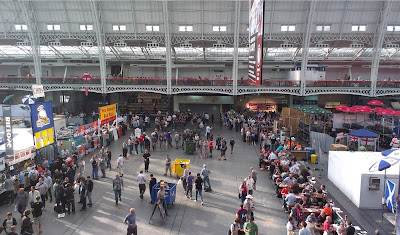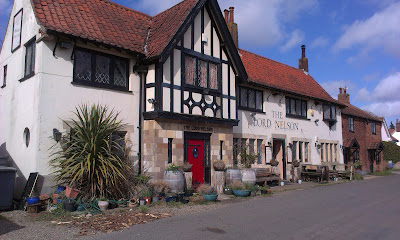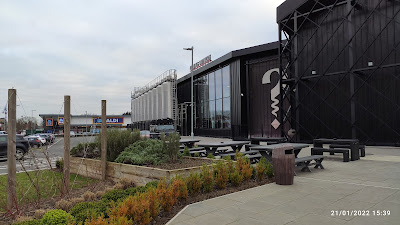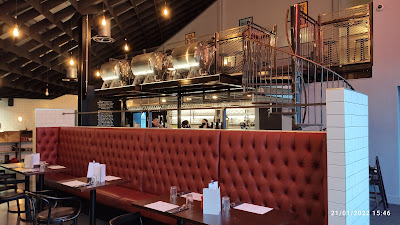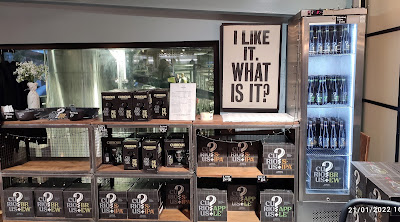At the start of my recent post about
Ashford, I brought up
the old adage that,
“You should never go back.” I said at the time that there
is more of a grain of truth in this piece of advice, but this does need
qualifying. I meant what I'd said, but with the following provisos, because sometimes you end up being pleasantly surprised, as I'll explain shortly.
Nothing stands still, and things change and evolve all the
time, and if you actually embrace the change, then when things aren’t quite
what you expected or indeed remembered, that’s not always a bad thing. There is
one strict condition here, and that is the change must be positive, as there’s no point
in going back and re-visiting a favourite place from your youth, if you find
it’s been altered out of all recognition. Even then, it still might represent a positive
change, if the alterations that have taken place are for the better, so the key
is to keep an open mind when returning to old haunts and places that have
sacred memories from childhood.
I experienced this, at first hand, a couple of Friday’s ago,
as part of that return visit to Ashford, and neighbouring Willesborough, as they
were the places where I not only grew up, but also spent my formative years.
So, as part of the planning for our trip, I paid careful attention to somewhere
suitable for a lunchtime drink, plus a bite to eat.
As the idea was to walk through the housing development
where my sister and I had lived with our parents, between the ages of
3 and
11, I was banking on finding
somewhere nearby. Straight away, I thought of the
Rose Inn, a pub I visited several
times as a child, with my parents and maternal grandparents. The latter made
regular visits from
London, after we first moved to
Kent, and as both enjoyed a
drink – unlike my parents, the
Rose was within easy walking distance, and a place that the whole family could enjoy.
It was an unusual pub, being built into the side of a hill,
and was therefore constructed on two levels. The public bar was at the higher
level, fronting the road, and a saloon-cum-games area, which doubled-up as
children's room, at the lower level. It was reached by descending a series of
steps from the road, and also the car park. I remember as a child, sitting out
at some tables in the top car park, enjoying a pineapple juice, and a packet of crisps.
My
grandmother’s tipple of choice was a
gin and tonic, but
my
grandfather was definitely a beer man. He preferred bottled, rather than
draught, and I think this was quite a common preference during the
early 60’s –
something to do with variability of the draught beer back then.
“Draught” would
invariably have been cask, and poor cellar skills shown by many licensees at the
time, helped lead to the development and wider promotion of
keg beer.
The latter, was originally, nothing more than bottled beer
but served and dispensed from a much larger container. My
grandfather stuck with his
bottles though, and whilst I have no idea of the brew served in the
Rose, at
the time, I imagine it would have been
Fremlin’s. I say this because shortly
after leaving school, I became re-acquainted with the pub. It was a
Whitbread
pub back then, the latter company having acquired most of its pubs in the area,
following the takeover of
Fremlin’s in
1967.
I hadn’t long turned
18, and along with a couple of former school friends,
had taken a job at a local food processing factory, whilst awaiting my
A-level
results. The work was dull, repetitive and boring, but paid reasonably well, and we were
placed on permanent late shift, which ran from
2pm until
10pm. Back in those
days most
Kent pubs closed at
10.30pm Monday to Thursday, with an extension to
11pm on
Fridays and Saturdays.
The
Rose was the nearest pub to the factory, and if we left
as soon as the shift ended, we just had time to hot foot it along to the
Rose
and get a couple of quick pints in before time was called. Presiding behind the
bar was this fearsome old lady called
Norah. She appeared to run the pub
single-handed, although we later learned that one of her sons helped with the
cellar work and other heavy duties. We tended to frequent the lower saloon bar
on our after-work visits, primarily to engage in a game or two of
bar-billiards, and despite our relatively young ages,
Norah seemed quite glad
of our custom.
One friend though, recounted a tale of how Norah had once
barred his father from the pub, purely because she "didn't like the look
of him,” we paid little attention to this story, as we really looked forward to
those after work beers, especially after a gruelling 8-hour shift. As proof of
this, the couple of pints we squeezed in before “last orders” were called,
barely touched the sides.
At the end of that summer, I left home to go to university.
When I returned the following summer, I had a different part-time job at a
location that was nowhere near the Rose. I consequently lost touch with the
pub, until a few weeks ago, when my interest was re-kindled, following a search
on What Pub, for a place in Willesborough, to enjoy that lunchtime drink.
I did something of a double take when I first saw the pub
and its address. It is no longer the
Rose, but instead goes under the name of
the
Hooden Smokehouse & Cellar, which puzzled me
somewhat as I remember a small chain of pubs all with the word “
Hooden” in
their title. We had one in Tonbridge, for a while, when the
Somerhill Arms was
renamed the
Hooden Horse.
That was quite a few years ago, and the pub has reverted to
its original name, but I’m not sure what the story was regarding the
Willesborough outlet. I wasn’t that bothered either, because the pub was open,
the food and drink offerings looked good and the reviews on TripAdvisor were
also positive, so the former Rose it was then. As mentioned in my Ashford article, the Hooden Smokehouse
& Cellar (HS&C), was just a few hundred yards past my old primary school, and as soon as we
arrived the outside of the pub looked familiar. One thing which was different,
was the upper bar was no longer accessible.
We walked down the steps to the lower bar instead, passing
through a covered area which serves as the games room. This led through into
the main bar which was the one I remembered as the saloon bar, nearly half a
century ago. There was a handful of people inside – a couple having lunch, as
the far end of the room, a couple of lads, sitting at the side of the bar, plus
the landlord who was doing some work on his computer.
We ordered some drinks and grabbed a copy of the menu. I
opted for the
Harvey’s Sussex Best, which was the only
cask ale on sale.
Matthew went for a pint of
Heineken. We both chose the
Dry Aged Beef Burger and
chips option for our lunch, and I have to say the food was excellent, and the
service prompt. The
Harvey’s was good too, which led me to order a second pint.
Afterwards I had an interesting chat with the landlord, and
the subject of the legendary former landlady, Norah came up. He had heard several
stories, from various sources, about Norah, and had even met one of her sons. I
told him one of mine, which sort of tied in with the tale my friend told, about
her refusing to serve his father. The story is too long to repeat here, but if you
click the link, it will direct you to a post I published in 2010, entitled
Fearsome Pub Landladies.
A few quick lines about the pub, to finish on. It was built
in
1648, as a coaching inn, and as remained a pub ever since. A serious fire broke
out in
November 2016. Because the fire started in duct-work, associated with the
extraction system, from one of the fryers, in the kitchen, it was some time before
it was noticed. This meant the damage was much more extensive than I might have
been, and consequently, the clean-up and rebuilding work necessary, meant the pub
didn’t re-open, until
March 2018.Unfortunately, the renovation work revealed some structural weaknesses, which meant that it was not possible to re-open the upstairs bar; without some prohibitively expensive remedial work. The landlord told me that steep, wooden, nautical-style which Norah clambered up and down between the bars, was still in place.
The pub’s menu places a strong emphasis on
American-style
food, with items such as ribs, pulled pork, chicken wings, as well as burgers,
a major feature of the
Hooden’s food offering. As for the beer, the landlord
did say that prior to
lock-down, he was running with
2-3 cask ales on, but had
(sensibly in my book), dropped this figure down to one. The pub also features two
or three craft offerings. On the landlord’s own admission, these are expensive at
around
£6 a pint, but they were selling.
The Hooden Smokehouse & Cellar is well worth checking
out if you are in the area, and with happy childhood memories for me, I’m
really glad that I stopped by, to re-live some of them.








